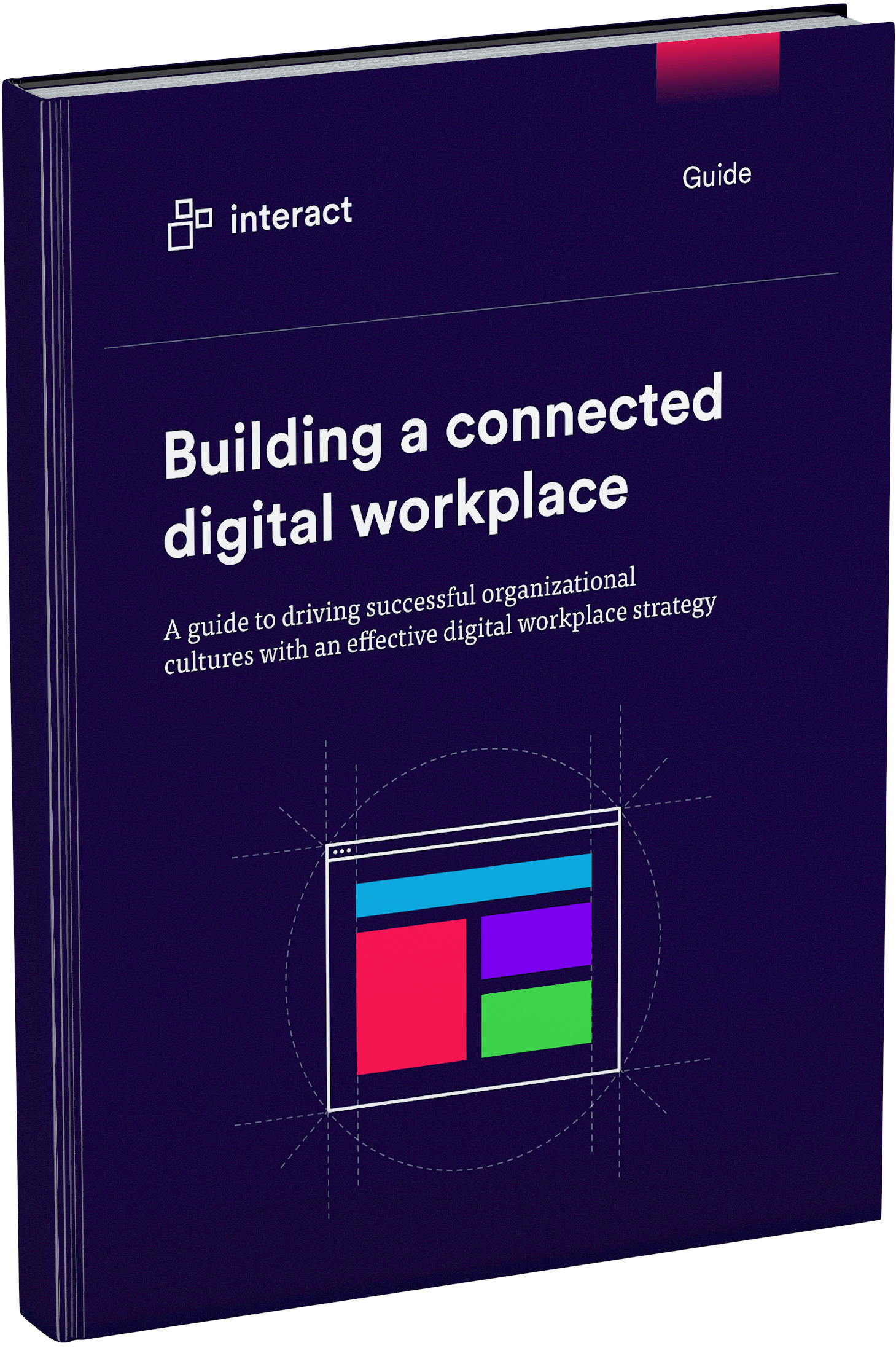11 ways an intranet can improve your digital employee experience

Do you have a strategy for your digital employee experience? Is there a focus on the relationship between your workforce and the digital tools that they use to fulfill their role? As more and more workplaces take on a digital transformation, we explore the reasons why the digital employee experience (DEX) within your organization should be a major priority – and why your intranet should be at the center of this journey.
What is the digital employee experience?
The employee experience is everything that your staff experiences at work. This can vary from how they operate the software available, how they communicate with their seniors and how they access information. In short, the employee experience is the catch-all term for the experiences of a worker in an organization.
As outlined in the blog, What is a digital employee experience?, DEX touches on different levels: the physical, sensorial, emotional and rational. What makes an employee choose one communication platform over another? Why are people more drawn to sharing information over one exchange than the next? How are people finding out information they need to do their job?
Building a connected digital workplace
DEX has been born from the development of software. As tech becomes more and more sophisticated, expectations of the intranet grow. No longer are they a rudimentary database and content storage. We’ve all seen how these systems can help with communication and engagement. So where is the intranet going to go next?
The digital employee experience and the evolution of the intranet go hand in hand. As DEX progresses, so does the modern intranet which adapts to the changing nature of the workplace in the 21st century.

Why is everyone focusing on the digital experience right now?
Above everything, when the term ‘digital employee experience’ is used, it refers to every interaction the workforce has with the digital tools they need to use. From logging in to contacting someone – organizations need to consider every touch point their employees have in a day.
There are two main reasons for this drive to master the digital employee experience. Firstly, advances in technology are heralding a new and sophisticated digital workplace where employees can work anywhere in the world and still be connected to their organization. Secondly, a new generation – the so-called Gen Zs – are joining the workplace. This has meant that businesses need to work hard to meet the expectations of a new cohort of employees who are more digital natives than ever before.
Who is responsible for DEX?
Like the running of an intranet, when it comes to DEX, there is an ongoing debate as to who takes on the responsibility. Because it’s ostensibly related to software, IT is an immediate choice to take ownership of it. However, DEX, is more than just software; this is the journey about the systems and the people who use them. How they communicate, collaborate and engage with these tools shapes how they are managed. For a department like IT, which is generally separated from the more humanistic aspects of running an organization, this is an unsuitable role.
For a better chance of success and longevity, others argue that a cohesive experience between digital tools and people should fall to those professionals in charge of internal communications and HR.
However, as some organizations have learned, appointing a specific department to steer digital employee experience means taking full ownership for it – and this can be difficult when different departments have different priorities.
Building a connected digital workplace
The ideal situation is creating a team made up with professionals from different areas of the business: IT, HR, internal comms, admin and senior-level leaders. With so many areas of expertise, the steering group can address any weak points, engage stakeholders, advise on the best course of action and can actively shape the system based on how their organization works. Everyone in this group must approach DEX as the employee’s user experience and make the intranet as necessary and attractive as possible to use daily.
Thus, a digital experience that works for everyone – and where the intranet is center stage – is born.

How the intranet is pivotal to DEX
As the digital employee experience describes the employee’s journey in everyday work and the experience he or she has with the various digital platforms, it makes sense to put the intranet – now often also known as an employee experience platform – at the center of this.
With a seamless user experience, an intranet can perform numerous tasks required for a digital workplace, making it an essential component of this evolution. Whether your intranet is an established part of your organization, or in the early planning stages, you need to make sure it has the features to carry out critical tasks. If you’re unsure whether your intranet is actively contributing to a functioning, seamless workplace, work out whether their features can do the following:
- Offer a cohesive experience: with Single Sign-On to allow the user to simplify application access, improve security and remove the pain of multiple logins. This means it’s easy to connect multiple employee portal examples to the digital workplace one homepage.
- Contribute towards a positive culture: helped by a social intranet which allows you to give employees more ways of communicating and collaborating. By providing the tools needed to share opinions, views, ideas, an intranet can provide the platform for innovation and new ways of thinking.
- Centralize training: the use of quizzes and modules can help you centralize your learning and keep all in-house training in one place – including results and achievements. This means all knowledge training is carried out by an in-house team and managed centrally.
- Automation: the creation of forms and processes allows employees to save time and improve accuracy. This means less burden on specific departments, more accuracy and improved security for certain procedures. This automation aids many roles within an organization and reduces the strain on internal resources by empowering staff to complete daily tasks such as booking leave and submitting expenses.
- Make content accessible: with the help of rich editing tools, you can create engaging, relevant and useful content from one place. This allows employees to get hold of relevant information that they need to do their work, and stops unnecessary time delays that occur when data, info, and news is obstructed.
- Digital tools that are centralized: to avoid app sprawl, confusion and using apps from ‘outside the circle,’ integration can be a significant asset. Bringing all business platforms and applications to create a centralized digital workplace means that users have access to leading third-party applications that enhance the way employees work. These specialized tools and platforms are available for different processes and functions; a successful intranet will bring these together in a centralized, streamlined approach, acting as a gateway to the digital workplace.
- Enhanced online collaboration: Break down company silos and simplify group collaboration across location and departments, by providing team spaces on the intranet for groups of common interest. Thanks to social features which allows comments, as well as a people directory and instant messenger support, staff can connect and work together. This then can act as a catalyst for strengthened working relationships, innovation and new ways of working.
- Knowledge management: an organization that can freely share knowledge is a powerful one. An intranet that borrows rich social features like forums, @mentioning, likes, shares, and comments are a way of building communities across organizations and sharing knowledge and ideas.
- Enterprise search functionality: put the right content into the hands of employees by providing a robust and comprehensive search across all your intranet content and cloud storage systems. If your users can’t find what they’re looking for, your intranet loses its relevance.
- Personalized content: using the ethos that ‘content should find people,’ your intranet should offer targeted content. Placing audiences into defined segments that share a common attribute, tailoring homepages has two benefits. It signposts content that users may need to get work done based on previous habits and also helps to uncover material that the user may not know existed.
- Aligned business objectives: when an organization has values and objectives that it wants to share and promote, then the intranet is the critical tool to do this on. For example, if your strategic business goal is for international expansion, does your intranet support a globalized workforce? Does it enable remote access, facilitate collaboration across different time zones, and offer the correct features and tools for different offices?
The benefits of DEX

Of course, with anything of this scale, there’s a lot of effort that goes behind the scenes. From organization to planning, responsibilities, and workloads – this is no small feat. So, is it worth the effort? When an intranet enhances the digital employee experience, what impact does it have on an organization?
In short, a modern intranet is a unifying platform that brings all relevant information and interactions into one place. Allowing smooth, cohesive interaction for everyone, whether it’s the CEO or the new starter creates an environment where accessing data, sharing knowledge and calling upon help and expertise is done without hindrance, obstacle or delay. This seamless digital employee experience allows your workforce to explore, learn and contribute to the ongoing growth of the organization.

